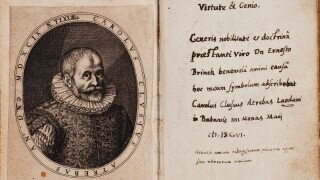A Dive Into The 16th Century's Version Of Facebook

In the 16th century, the need to stay in touch with friends and high-status connections existed, though not in the form of the internet (which wouldn't be invented for at least like dozens of years). Instead, something more tangible known as alba amicorum, Latin for "book of friends," is what was used to keep records of your friends, their interests, and their "it's complicated" statuses -- pretty much the earliest version of Facebook.
Not quite a Burn Book from Mean Girls yet capable of dropping people you no longer wanted associations with, a simple X drawn across a person's entry is speculated to have been equivalent of deleting someone. The higher the status, the closer the person would get to having their entry appear at the beginning of these books that were passed around to friends, and sometimes even plebeians who knew a guy and could have royalty sign their book of friendship. Instructors, noblemen, and churchmen were usually asked to sign these books by their students, with many having been kept as a part of various universities' history.

Don't Miss
The book was a blend of an autograph book and diary, occurring mainly amongst young German and Dutch people. As a token of friendship, the trend was especially in with students. As the Guardian puts it, "Renaissance millennials" would get signatures of sometimes famous people of their time; for example, the British Library hosts a friendship book bearing the autograph of King Charles I, "equivalent to a Lady Gaga today." Sketches found in these have been compared to selfies, as interpretive drawings of friends were often found in these journals.

With the release of the printing press in the 17th and 18th centuries, the wealthier population could buy pre-printed friendship books embellished in fancy lettering and built-in templates for writing and illustrations to be placed into. When asked by Hyperallergic, Dr. Earle Havens, Curator of Rare Books & Manuscripts at Johns Hopkins, notes, "Facebook is simply doing something that we've needed to do for a long time — which is to capture the ephemeral nature of friendship as we encounter our friends in the passage of time and across space." Or deleting toxic ones.
Oftentimes books also mimicked the clout chasing of modern times, as excavated ones have been found with blank opening pages. Those were reserved for high-status people and intentionally left empty on the off chance everyday people would meet them, like a plastic-covered granny couch awaiting the asses of those worthy enough to unwrap them.
Top Image: Ernst Brinck